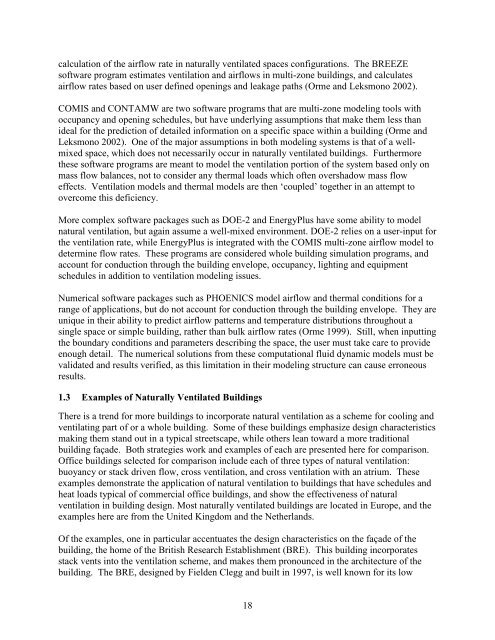Methodology for the Evaluation of Natural Ventilation in ... - Cham
Methodology for the Evaluation of Natural Ventilation in ... - Cham
Methodology for the Evaluation of Natural Ventilation in ... - Cham
You also want an ePaper? Increase the reach of your titles
YUMPU automatically turns print PDFs into web optimized ePapers that Google loves.
calculation <strong>of</strong> <strong>the</strong> airflow rate <strong>in</strong> naturally ventilated spaces configurations. The BREEZEs<strong>of</strong>tware program estimates ventilation and airflows <strong>in</strong> multi-zone build<strong>in</strong>gs, and calculatesairflow rates based on user def<strong>in</strong>ed open<strong>in</strong>gs and leakage paths (Orme and Leksmono 2002).COMIS and CONTAMW are two s<strong>of</strong>tware programs that are multi-zone model<strong>in</strong>g tools withoccupancy and open<strong>in</strong>g schedules, but have underly<strong>in</strong>g assumptions that make <strong>the</strong>m less thanideal <strong>for</strong> <strong>the</strong> prediction <strong>of</strong> detailed <strong>in</strong><strong>for</strong>mation on a specific space with<strong>in</strong> a build<strong>in</strong>g (Orme andLeksmono 2002). One <strong>of</strong> <strong>the</strong> major assumptions <strong>in</strong> both model<strong>in</strong>g systems is that <strong>of</strong> a wellmixedspace, which does not necessarily occur <strong>in</strong> naturally ventilated build<strong>in</strong>gs. Fur<strong>the</strong>rmore<strong>the</strong>se s<strong>of</strong>tware programs are meant to model <strong>the</strong> ventilation portion <strong>of</strong> <strong>the</strong> system based only onmass flow balances, not to consider any <strong>the</strong>rmal loads which <strong>of</strong>ten overshadow mass floweffects. <strong>Ventilation</strong> models and <strong>the</strong>rmal models are <strong>the</strong>n ‗coupled‘ toge<strong>the</strong>r <strong>in</strong> an attempt toovercome this deficiency.More complex s<strong>of</strong>tware packages such as DOE-2 and EnergyPlus have some ability to modelnatural ventilation, but aga<strong>in</strong> assume a well-mixed environment. DOE-2 relies on a user-<strong>in</strong>put <strong>for</strong><strong>the</strong> ventilation rate, while EnergyPlus is <strong>in</strong>tegrated with <strong>the</strong> COMIS multi-zone airflow model todeterm<strong>in</strong>e flow rates. These programs are considered whole build<strong>in</strong>g simulation programs, andaccount <strong>for</strong> conduction through <strong>the</strong> build<strong>in</strong>g envelope, occupancy, light<strong>in</strong>g and equipmentschedules <strong>in</strong> addition to ventilation model<strong>in</strong>g issues.Numerical s<strong>of</strong>tware packages such as PHOENICS model airflow and <strong>the</strong>rmal conditions <strong>for</strong> arange <strong>of</strong> applications, but do not account <strong>for</strong> conduction through <strong>the</strong> build<strong>in</strong>g envelope. They areunique <strong>in</strong> <strong>the</strong>ir ability to predict airflow patterns and temperature distributions throughout as<strong>in</strong>gle space or simple build<strong>in</strong>g, ra<strong>the</strong>r than bulk airflow rates (Orme 1999). Still, when <strong>in</strong>putt<strong>in</strong>g<strong>the</strong> boundary conditions and parameters describ<strong>in</strong>g <strong>the</strong> space, <strong>the</strong> user must take care to provideenough detail. The numerical solutions from <strong>the</strong>se computational fluid dynamic models must bevalidated and results verified, as this limitation <strong>in</strong> <strong>the</strong>ir model<strong>in</strong>g structure can cause erroneousresults.1.3 Examples <strong>of</strong> <strong>Natural</strong>ly Ventilated Build<strong>in</strong>gsThere is a trend <strong>for</strong> more build<strong>in</strong>gs to <strong>in</strong>corporate natural ventilation as a scheme <strong>for</strong> cool<strong>in</strong>g andventilat<strong>in</strong>g part <strong>of</strong> or a whole build<strong>in</strong>g. Some <strong>of</strong> <strong>the</strong>se build<strong>in</strong>gs emphasize design characteristicsmak<strong>in</strong>g <strong>the</strong>m stand out <strong>in</strong> a typical streetscape, while o<strong>the</strong>rs lean toward a more traditionalbuild<strong>in</strong>g façade. Both strategies work and examples <strong>of</strong> each are presented here <strong>for</strong> comparison.Office build<strong>in</strong>gs selected <strong>for</strong> comparison <strong>in</strong>clude each <strong>of</strong> three types <strong>of</strong> natural ventilation:buoyancy or stack driven flow, cross ventilation, and cross ventilation with an atrium. Theseexamples demonstrate <strong>the</strong> application <strong>of</strong> natural ventilation to build<strong>in</strong>gs that have schedules andheat loads typical <strong>of</strong> commercial <strong>of</strong>fice build<strong>in</strong>gs, and show <strong>the</strong> effectiveness <strong>of</strong> naturalventilation <strong>in</strong> build<strong>in</strong>g design. Most naturally ventilated build<strong>in</strong>gs are located <strong>in</strong> Europe, and <strong>the</strong>examples here are from <strong>the</strong> United K<strong>in</strong>gdom and <strong>the</strong> Ne<strong>the</strong>rlands.Of <strong>the</strong> examples, one <strong>in</strong> particular accentuates <strong>the</strong> design characteristics on <strong>the</strong> façade <strong>of</strong> <strong>the</strong>build<strong>in</strong>g, <strong>the</strong> home <strong>of</strong> <strong>the</strong> British Research Establishment (BRE). This build<strong>in</strong>g <strong>in</strong>corporatesstack vents <strong>in</strong>to <strong>the</strong> ventilation scheme, and makes <strong>the</strong>m pronounced <strong>in</strong> <strong>the</strong> architecture <strong>of</strong> <strong>the</strong>build<strong>in</strong>g. The BRE, designed by Fielden Clegg and built <strong>in</strong> 1997, is well known <strong>for</strong> its low18
















